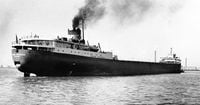Fifty years ago, on November 10, 1975, the Edmund Fitzgerald—then the largest freighter on the Great Lakes—vanished beneath the icy waters of Lake Superior, taking all 29 crew members with her. Today, the memory of that tragedy resonates as powerfully as ever, woven into the fabric of Great Lakes culture and immortalized by Gordon Lightfoot’s haunting ballad. As communities across the region prepare to mark the half-century since the ship’s loss, the story of the Fitzgerald continues to captivate, mourn, and inspire.
The Edmund Fitzgerald’s final voyage began on November 9, 1975, when she left Superior, Wisconsin, loaded with 26,000 tons of iron ore bound for Zug Island in Detroit. The Fitzgerald, affectionately known as the "Fitz," was a 730-foot colossus, named for a Milwaukee insurance executive. At her launch in 1958, she was the largest ship on the lakes, holding that title until 1971. Most of her crew hailed from states bordering the Great Lakes—Wisconsin, Michigan, Ohio, and Minnesota—and her captain, Ernest M. McSorley, was a seasoned mariner known for his storm navigation skills. At 63, McSorley intended to retire after the 1975 season, but fate had other plans.
As the Fitzgerald steamed east, gale warnings were posted on the night of November 9, escalating to storm warnings by the early hours of November 10. The crew of the Arthur Anderson, a nearby vessel, reported waves as high as 25 feet. Amid these monstrous seas, the Fitzgerald sustained damage. In his last radio message, Captain McSorley reported, "We are holding our own." That was the final communication from the ship. No distress call ever came.
Debbie Gomez-Felder, daughter of crewman Oliver “Buck” Champeau, was just 17 when her father joined the Fitzgerald for the first time, lured by the higher pay that came with the season’s increased risks. She recalls the shock of being called out of class and sent home, only to learn her father’s ship was missing. "I was banging on the church doors at St. Michael’s Church, our home church where I grew up, wanting answers from one of the priests as to how could this happen," Gomez-Felder told the Associated Press. "I didn’t understand it." The pain of loss was compounded by the fact that none of the crew’s bodies were ever recovered. The Fitzgerald remains at rest 535 feet below the surface, about 17 miles north-northwest of Whitefish Point, Michigan.
The cause of the sinking remains a mystery. Over the decades, theories have ranged from rogue waves to structural failure, but no definitive answer has emerged. Nevertheless, the disaster spurred significant improvements in shipping safety on the Great Lakes. Frederick Stonehouse, author of The Wreck of the Edmund Fitzgerald, noted, "Every sailor on the Great Lakes that’s sailing today owes a great deal of debt of gratitude to the Fitzgerald." Before 1975, ships of similar size were lost every six or seven years; since then, not a single comparable vessel has gone down.
Yet, what truly sets the Fitzgerald apart from the roughly 6,500 other ships lost on the Great Lakes isn’t just the scale of the tragedy—it’s the enduring legacy of Gordon Lightfoot’s song. Lightfoot, inspired by early news reports and a Newsweek article, released "The Wreck of the Edmund Fitzgerald" in August 1976, less than a year after the sinking. The song’s mournful storytelling and evocative imagery propelled the event into global infamy. John U. Bacon, author of The Gales of November, observed, "The song has made this by far the most famous Great Lakes shipwreck." In fact, the Fitzgerald now trails only the Titanic—and perhaps the Lusitania—in worldwide recognition.
Rick Haynes, who played bass on the original recording and performed with Lightfoot for 55 years, described the song’s power: "When you listen to the record Edmund Fitzgerald, it’s like he’s putting you right there, like he was right there. And that’s pretty hard to do with a tragedy like that, you know?" For Gomez-Felder, the song was initially too painful to hear, but she eventually found solace in its words. "The part that says ‘All that remains are the faces and the names of the wives and the sons and the daughters,’ I thought there wasn’t a word he missed. There wasn’t anything he didn’t recognize."
Lightfoot’s devotion to the story extended beyond the song. He regularly met with victims’ families and even altered his lyrics to reflect their concerns, removing references to disproven theories about the cause of the sinking. His widow, Kim Lightfoot, told the Associated Press, "Just as he eulogized the tragedy in song for the world, he also kept the memory alive in our home; Paintings, models and tributes adorned the walls and followed us from room to room as we went about our daily lives." Lightfoot died in 2023, but his band continues to perform the song at every concert, ensuring the legend lives on for new generations—many of whom discover it through social media platforms like TikTok.
The Fitzgerald’s legacy is honored in many ways. The Great Lakes Historical Museum in Whitefish Point, which houses the ship’s bell—retrieved in 1995 at the request of the crew’s families—will host a public event on November 10. A separate, livestreamed ceremony will be held just for the families. Bruce Lynn, executive director of the Great Lake Shipwreck Historical Society, expects record attendance this year, noting the museum is "on track to see its busiest year ever on the 50th anniversary." The bell will be rung 30 times: once for each crew member, and a final time for all sailors lost on the Great Lakes. The Mariners’ Church in Detroit, memorialized in Lightfoot’s song, will also ring its bell 30 times, a tradition that began in 1975 and continues to this day.
The commemorations extend beyond museums and churches. In Escanaba, Michigan, the Players de Noc theater group will perform a stage reading of Steven Dietz’s Ten November, concluding with a bell ceremony to honor the Fitzgerald’s crew and all lost sailors. Jeff Woerpel, the director, reflected on the tragedy’s impact: "It had a big impact on the people who were alive at the time. I remember that I was in fourth grade when it happened in 1975. I remember the teacher telling us about it and the displays that were put up in the classroom. I think it’s important for that stuff to be remembered and still, and I think it’s still in everyone’s memories. It’s important for us."
For families like Gomez-Felder’s, the anniversary is a time of reflection and connection. She travels to Whitefish Point each year, finding comfort among others who share her loss. For the past 30 years, she has rung the Fitzgerald’s bell in memory of her father. "That was the closest thing to my dad," she said. "That’s the soul of the ship."
Half a century on, the wreck of the Edmund Fitzgerald remains a touchstone for the Great Lakes region and beyond—a story of tragedy, remembrance, and resilience. The legend lives on, not just in song, but in the hearts of those who remember and honor the 29 men lost to the gales of November.


